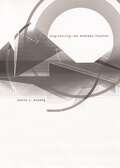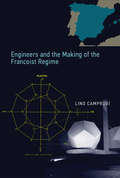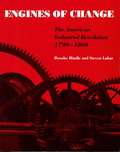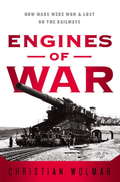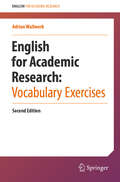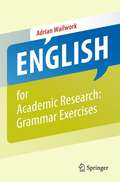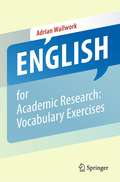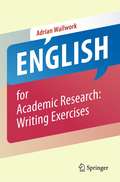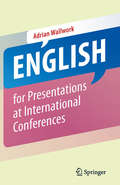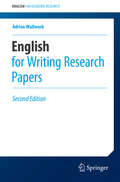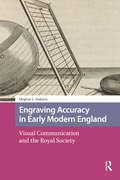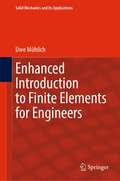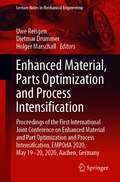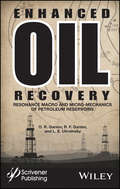- Table View
- List View
Engineering-Medicine: Principles and Applications of Engineering in Medicine
by Lawrence S. Chan and William C. TangThis transformative textbook, first of its kind to incorporate engineering principles into medical education and practice, will be a useful tool for physicians, medical students, biomedical engineers, biomedical engineering students, and healthcare executives. The central approach of the proposed textbook is to provide principles of engineering as applied to medicine and guide the medical students and physicians in achieving the goal of solving medical problems by engineering principles and methodologies. For the medical students and physicians, this proposed textbook will train them to “think like an engineer and act as a physician”. The textbook contains a variety of teaching techniques including class lectures, small group discussions, group projects, and individual projects, with the goals of not just helping students and professionals to understand the principles and methods of engineering, but also guiding students and professionals to develop real-life solutions. For the biomedical engineers and biomedical engineering students, this proposed textbook will give them a large framework and global perspective of how engineering principles could positively impact real-life medicine. To the healthcare executives, the goal of this book is to provide them general guidance and specific examples of applying engineering principles in implementing solution-oriented methodology to their healthcare enterprises. Overall goals of this book are to help improve the overall quality and efficiency of healthcare delivery and outcomes.
Engineering: An Illustrated History from Ancient Craft to Modern Technology
by Tom JacksonFrom ancient aqueducts to soaring skyscrapers, explore engineering milestones over the centuries. Combining engaging text with captivating images and helpful diagrams, renowned science writer Tom Jackson guides readers through the history of Engineering in the 7th installment of the groundbreaking PonderablesTM series. Engineering is all around us. From our bridges, tunnels and skyscrapers, to our cars, computers and smartphones, engineering shapes our world and influences just about everything we see and do. And it s been that way for longer than you might think. From the crudely knapped hand axes of our human ancestor Homo Habilis to the mind-blowing ways in which modern engineering has improved our quality of daily life and expanded the scope of our civilization, the story of engineering is the story of humankind itself. In a series of 100 enlightening articles, this book tells that incredible story by exploring the biggest names, grandest achievements and greatest inventions of the engineering world from prehistory all the way up to present day. Carefully curated, beautifully illustrated and addictively fun, this volume is your ultimate guide to the dreamers, thinkers, tinkerers and builders that make our world.
Engineering—An Endless Frontier
by Sunny Y. AUYANGGenetic engineering, nanotechnology, astrophysics, particle physics: We live in an engineered world, one where the distinctions between science and engineering, technology and research, are fast disappearing. This book shows how, at the dawn of the twenty-first century, the goals of natural scientists--to discover what was not known--and that of engineers--to create what did not exist--are undergoing an unprecedented convergence. Sunny Y. Auyang ranges widely in demonstrating that engineering today is not only a collaborator with science but its equal. In concise accounts of the emergence of industrial laboratories and chemical and electrical engineering, and in whirlwind histories of the machine tools and automobile industries and the rise of nuclear energy and information technology, her book presents a broad picture of modern engineering: its history, structure, technological achievements, and social responsibilities; its relation to natural science, business administration, and public policies. Auyang uses case studies such as the development of the F-117A Nighthawk and Boeing 777 aircraft, as well as the experiences of engineer-scientists such as Oliver Heaviside, engineer-entrepreneurs such as Henry Ford and Bill Gates, and engineer-managers such as Alfred Sloan and Jack Welch to give readers a clear sense of engineering's essential role in the future of scientific research. Table of Contents: Preface 1. Introduction 2 . Technology Takes Off 2.1 From Practical Art to Technology 2.2 Construction Becomes Mathematical 2.3 Experimenting with Machines 2.4 Science and Chemical Industries 2.5 Power and Communication 3. Engineering for Information 3.1 From Microelectronics to Nanotechnology 3.2 Computer Hardware and Software 3.3 Wireless, Satellites, and the Internet 4. Engineering in Society 4.1 Social Ascent and Images of Engineers 4.2 Partnership in Research and Development 4.3 Contributions to Sectors of the Economy 5. Innovation by Design 5.1 Inventive Thinking in Negative Feedback 5.2 Design Processes in Systems Engineering 5.3 “Working Together� in Aircraft Development 5.4 From Onboard Computers to Door Hinges 6. Sciences of Useful Systems 6.1 Mathematics in Engineering and Science 6.2 Information and Control Theories 6.3 Wind Tunnels and Internet Simulation 6.4 Integrative Materials Engineering 6.5 Biological Engineering Frontiers 7. Leaders Who Are Engineers 7.1 Business Leaders in the Car Industry 7.2 Public Policies and Nuclear Power 7.3 Managing Technological Risks Appendix A. Statistical Profiles of Engineers Appendix B. U.S. Research and Development Notes Index I am impressed by the scope of Engineering - An Endless Frontier, and fascinated by Sunny Auyang's comprehensive knowledge of the subject. This is just the kind of book the National Academy of Engineering has been encouraging to promote the importance of engineering to the public. It will have a long shelf-life in that it pulls together material that is not readily accessible, and will serve as a reference for anyone interested in engineering as a profession. Engineering needs this book!--John Hutchinson, Harvard UniversityEngineering - An Endless Frontier is extraordinary in scope. Sunny Auyang describes the different kinds of contemporary engineering practices and productions, attempts to provide historical background, explains the scientific basis for engineering innovation in different fields, and addresses the broad, systems level managerial, entrepreneurial, and design activities of professionals. It's rare to find a single author who can grasp and explain the essential features of modern technologies across such an array of industrial sectors and engineering disciplines and explain how they work, why they work they way they do,
Engineers and the Making of the Francoist Regime
by Lino CamprubíIn this book, Lino Camprubí argues that science and technology were at the very center of the building of Franco's Spain. Previous histories of early Francoist science and technology have described scientists and engineers as working "under" Francoism, subject to censorship and bound by politically mandated research agendas. Camprubí offers a different perspective, considering instead scientists' and engineers' active roles in producing those political mandates. Many scientists and engineers had been exiled, imprisoned, or executed by the regime. Camprubí argues that those who remained made concrete the mission of "redemption" that Franco had invented for himself. This gave them the opportunity to become key actors -- and mid-level decision makers -- within the regime. Camprubí describes a series of projects across Spain undertaken by the civil engineers and agricultural scientists who placed themselves at the center of their country's forced modernization. These include a coal silo, built in 1953, viewed as an embodiment of Spain's industrialized landscape; links between laboratories, architects, and the national Catholic church (and between technology and authoritarian control); vertically organized rice production and research on genetics; river management and the contested meanings of self-sufficiency; and the circulation of construction standards by mobile laboratories as an engine for European integration. Separately, each chapter offers a fascinating microhistory that illustrates the coevolution of Francoist science, technology, and politics. Taken together, they reveal networks of people, institutions, knowledge, artifacts, and technological systems woven together to form a new state.
Engineers and the Making of the Francoist Regime (Transformations: Studies in the History of Science and Technology)
by Lino CamprubiHow engineers and agricultural scientists became key actors in Franco's regime and Spain's forced modernization.In this book, Lino Camprubí argues that science and technology were at the very center of the building of Franco's Spain. Previous histories of early Francoist science and technology have described scientists and engineers as working “under” Francoism, subject to censorship and bound by politically mandated research agendas. Camprubí offers a different perspective, considering instead scientists' and engineers' active roles in producing those political mandates. Many scientists and engineers had been exiled, imprisoned, or executed by the regime. Camprubí argues that those who remained made concrete the mission of “redemption” that Franco had invented for himself. This gave them the opportunity to become key actors—and mid-level decision makers—within the regime.Camprubí describes a series of projects across Spain undertaken by the civil engineers and agricultural scientists who placed themselves at the center of their country's forced modernization. These include a coal silo, built in 1953, viewed as an embodiment of Spain's industrialized landscape; links between laboratories, architects, and the national Catholic church (and between technology and authoritarian control); vertically organized rice production and research on genetics; river management and the contested meanings of self-sufficiency; and the circulation of construction standards by mobile laboratories as an engine for European integration. Separately, each chapter offers a fascinating microhistory that illustrates the coevolution of Francoist science, technology, and politics. Taken together, they reveal networks of people, institutions, knowledge, artifacts, and technological systems woven together to form a new state.
Engineers of Dreams: Great Bridge Builders and the Spanning of America
by Henry PetroskiPetroski reveals the science and engineering--not to mention the politics, egotism, and sheer magic--behind America's great bridges, particularly those constructed during the great bridge-building era starting in the 1870s and continuing through the 1930s. It is the story of the men and women who built the St. Louis, the George Washington, and the Golden Gate bridges, drawing not only on their mastery of numbers but on their gifts for persuasion and self-promotion. It is an account of triumphs and ignominious disasters (including the Tacoma Narrows Bridge, which literally twisted itself apart in a high wind). And throughout this grandly engaging book, Petroski lets us see how bridges became the "symbols and souls" of our civilization, as well as testaments to their builders' vision, ingenuity, and perseverance. "Seamlessly linked. . . With astonishing scope and generosity of view, Mr. Petroski places the tradition of American bridge-building in perspective. "--New York Times Book Review
Engines and Fuels for Future Transport (Energy, Environment, and Sustainability)
by Avinash Kumar Agarwal Gautam Kalghatgi Felix Leach Kelly SenecalThis book focuses on clean transport and mobility essential to the modern world. It discusses internal combustion engines (ICEs) and alternatives like battery electric vehicles (BEVs) which are growing fast. Alternatives to ICEs start from a very low base and face formidable environmental, material availability, and economic challenges to unlimited and rapid growth. Hence ICEs will continue to be the main power source for transport for decades to come and have to be continuously improved to improve transport sustainability. The book highlights the need to assess proposed changes in the existing transport system on a life cycle basis. The volume includes chapters discussing the challenges faced by ICEs as well as chapters on novel fuels and fuel/ engine interactions which help in this quest to improve the efficiency of ICE and reduce exhaust pollutants. This book will be of interest to those in academia and industry alike.
Engines of Change: The American Industrial Revolution 1790-1860
by Brooke Hindle Steven LubarTHE MATERIAL ASPECTS OF AMERICAN LIFE UNDERWENT GREAT CHANGE in the period from 1790 to 1860, a pattern of development often referred to as the American Industrial Revolution. At the center of this transformation was a series of technological developments that were directly associated with labor, management, and organizational change. This book's discussion begins with physical survivals of technologies of that era, most of them preserved in the Smithsonian Institution. The book, like the exhibition from which it is derived (also entitled Engines of Change), endeavors to look through these artifacts to gain an understanding of the Industrial Revolution that differs significantly from popular perceptions. Specific insights can be gained from three dimensional survivals and from two dimensional views that are neither available in written accounts nor communicable through words alone. The photographs, drawings, and maps included here are, consequently, more than mere illustrations, more than a pleasant way to underline the written text. Indeed, in some ways they constitute the book's primary message. At the same time, the most obvious message conveyed by artifacts and pictures is limited by its unavoidable specificity. It must always be placed in a larger and broader context. Occasionally, observers bring enough context with them to interpret the artifacts they see, but usually extended verbal explanation is required to make objects and pictures truly meaningful. That is the purpose of the text of this book- to provide the context, to look through the physical survivals to an enriched comprehension of the technology and related aspects of the American Industrial Revolution.
Engines of War: How Wars Were Won & Lost on the Railways
by Christian WolmarBefore the nineteenth century, armies had to rely on slow and unreliable methods of transportation to move soldiers and equipment during times of conflict. But with the birth of the railroad in the early 1830s, the way wars were fought would change forever. In Engines of War, renowned expert Christian Wolmar tells the story of that transformation, examining all the engagements in which railways played a part from the Crimean War and American Civil War through both world wars, the Korean War, and the Cold War with its mysterious missile trains. He shows that the 'iron road' not only made armies far more mobile, but also greatly increased the scale and power of available weaponry. Wars began to be fought across wider fronts and over longer timescales, with far deadlier consequences. From armored engines with their swiveling guns to track sabotage by way of dynamite, railway lines constructed across frozen Siberian lakes and a Boer war ambush involving Winston Churchill, Engines of War shows how the railways - a fantastic generator of wealth in peacetime - became a weapon of war exploited to the full by governments across the world.
Engines: The Inner Workings of Machines That Move the World
by Theodore GrayThe international bestselling author of How Things Work and The Elements Trilogy turns his focus to a visual exploration of the inner workings and functionality of the marvelous machines that run our world—from the first steam engines to giant turbines to today's tiny electrical engines. In Engines, the always entertaining and informative Theodore Gray explores the glorious guts and intricate innards of dozens of impressive machines. Through his engaging and unexpected stories and Nick Mann&’s trademark gorgeous photography, Gray takes us on a journey from ancient Greek steam engines to our most sophisticated twenty-first-century machinery. We take time to appreciate the detailed functionality of the internal combustion engine, the connection between magnetism and electric motors, as well as hydraulics, robotics, and more. Each chapter builds on the previous, illuminating the evolution of engines and revealing the ingenuity brought to bear as humans invented and perfected these marvelous mechanical systems. Along the way, Gray regales us with tales of his own experiences working with and collecting these machines. For fans of how things are made and how they work, Engines is a loving tribute to the mechanical world.
English for Academic Research: Vocabulary Exercises (English for Academic Research)
by Adrian WallworkThis book is based on a study of referees' reports and letters from journal editors on reasons why papers written by non-native researchers are rejected due to problems with English (long sentences, redundancy, poor structure etc.). It draws on English-related errors from around 5000 papers written by non-native authors, around 3000 emails, 500 abstracts by PhD students, and over 1500 hours of teaching researchers how to write and present research papers. The exercises are organized into thirteen chapters on: adjectives and adverbs (e.g. actual vs current, different vs several, continually vs continuously), link words (e.g. on the contrary vs on the other hand, despite vs nevertheless), nouns (e.g. danger vs hazard, measure vs measurement), prepositions (e.g. among vs between, in vs into, with vs within), verbs (e.g. check vs control, compose vs comprise, arise vs raise, exclude vs rule out), false friends and synonyms, spelling, useful phrases, inclusive vocabulary, emails, using Large Language Models for correcting, paraphrasing, and translating.Nearly all exercises require no actual writing but simply choosing between various options, thus facilitating self-study, e-reading and rapid progress.The exercises can also be integrated into English for Academic Purposes (EAP) and English for Special Purposes (ESP) courses at universities and research institutes.The book can be used in conjunction with the other exercise books in the series:English for Academic Research: Writing ExercisesEnglish for Academic Research: Grammar ExercisesAdrian Wallwork edits scientific papers and teaches English for Academic Purposes (EAP) to PhD students. In addition to his many books for Springer, he has written course books for Oxford University Press and discussion books for Cambridge University Press.
English for Academic Research: Grammar Exercises
by Adrian WallworkThis book is based on a study of referees' reports and letters from journal editors on reasons why papers written by non-native researchers are rejected due to problems with English grammar. It draws on English-related errors from around 5000 papers written by non-native authors, several hundred emails, 500 abstracts by PhD students, and over 1000 hours of teaching researchers how to write and present research papers. The exercises include the following areas: active vs passive, use of wearticles (a/an, the, zero) and quantifiers (some, any, few etc)conditionals and modalscountable and uncountable nounsgenitiveinfinitive vs -ing formnumbers, acronyms, abbreviationsrelative clauses and which vs thattenses (e.g. simple present, simple past, present perfect)word orderExercise types are repeated for different contexts. For example, the difference between the simple present, present perfect and simple past is tested for use in papers, referees' reports, and emails of various types. Such repetition of similar types of exercises is perfect for revision purposes. English for Academic Research: Grammar Exercises is designed for self-study and there is a key to all exercises. Most exercises require no actual writing but simply choosing between various options, thus facilitating e-reading and rapid progress. The exercises can also be integrated into English for Academic Purposes (EAP) and English for Special Purposes (ESP) courses at universities and research institutes. The book can be used in conjunction with the other exercise books in the series and is cross-referenced to: English for Research: Usage, Style, and GrammarEnglish for Writing Research PapersEnglish for Academic Correspondence and Socializing Adrian Wallwork is the author of around 30 ELT and EAP textbooks. He has trained several thousand PhD students from 35 countries to write and present academic work. English for Writing Research PapersEnglish for Academic Correspondence and Socializing Adrian Wallwork is the author of around 30 ELT and EAP textbooks. He has trained several thousand PhD students from 35 countries to write and present academic work. English for Academic Correspondence and Socializing Adrian Wallwork is the author of around 30 ELT and EAP textbooks. He has trained several thousand PhD students from 35 countries to write and present academic work.
English for Academic Research: Vocabulary Exercises
by Adrian WallworkThis book is based on a study of referees' reports and letters from journal editors on reasons why papers written by non-native researchers are rejected due to problems with English (long sentences, redundancy, poor structure etc). It draws on English-related errors from around 5000 papers written by non-native authors, around 3000 emails, 500 abstracts by PhD students, and over 1000 hours of teaching researchers how to write and present research papers. The exercises are organized into nine chapters on: adjectives and adverbs (e.g. actual vs current, different vs several, continually vs continuously), link words (e.g. on the contrary vs on the other hand, despite vs nevertheless), nouns (e.g. danger vs hazard, measure vs measurement), prepositions (e.g. among vs between, in vs into, with vs within), verbs (e.g. check vs control, compose vs comprise, arise vs raise, exclude vs rule out), false friends and synonyms, spelling, useful phrases, emails Nearly all exercises require no actual writing but simply choosing between various options, thus facilitating self-study, e-reading and rapid progress. The exercises can also be integrated into English for Academic Purposes (EAP) and English for Special Purposes (ESP) courses at universities and research institutes. The book can be used in conjunction with the other exercise books in the series: English for Academic Research: Writing Exercises English for Academic Research: Grammar Exercises
English for Academic Research: Writing Exercises
by Adrian WallworkThis book is based on a study of referees' reports and letters from journal editors on reasons why papers written by non-native researchers are rejected due to problems with English (long sentences, redundancy, poor structure etc). It draws on English-related errors from around 5000 papers written by non-native authors, around 3000 emails, 500 abstracts by PhD students, and over 1000 hours of teaching researchers how to write and present research papers. The exercises are organized into ten chapters on: punctuation and spellingword orderwriting short sentences and paragraphslink words - connecting phrases and sentences togetherbeing concise and removing redundancyambiguity and political correctnessparaphrasing and avoiding plagiarismdefining, comparing, evaluating and highlightinganticipating possible objections, indicating level of certainty, discussion limitations, hedging, future workwriting each section of a paperSome exercises require no actual writing but simply choosing between various options, thus facilitating self-study, e-reading and rapid progress. In those exercises where extended writing is required, model answers are given. Exercise types are repeated for different contexts, for example the importance of being concise is tested for use in papers, referees' reports, and emails of various types. Such repetition of similar types of exercises is designed to facilitate revision. The exercises can also be integrated into English for Academic Purposes (EAP) and English for Special Purposes (ESP) courses at universities and research institutes. The book can be used in conjunction with the other exercise books in the series and is cross-referenced to: English for Research: Usage, Style, and Grammar English for Writing Research Papers
English for Presentations at International Conferences
by Adrian WallworkGood presentation skills are key to a successful career in academia. This book is the first guide to giving presentations at international conferences specifically written for researchers of all disciplines whose first language is not English.<P><P> With easy-to-follow rules and tips, and with examples taken from real presentations, you will learn how to:<P> * avoid errors in English by using short easy-to-say sentences<P> * improve your English pronunciation and intonation<P> * gain confidence, and overcome nerves and embarrassment<P> * plan, prepare and practice a well-organized, interesting presentation<P> * highlight the essential points you want your audience to remember<P> * deal with questions from the audience<P> * decide what to say at each stage of the presentation<P> * use standard phrases<P> * attract and retain audience attention
English for Presentations at International Conferences, Second edition
by Adrian WallworkGood presentation skills are key to a successful career in academia. This guide provides examples taken from real presentations given both by native and non-native academics covering a wide variety of disciplines.<P><P> The easy-to-follow guidelines and tips will teach you how to: <P> * plan, prepare and practice a well-organized, interesting presentation<P> * avoid errors in English by using short easy-to-say sentences<P> * improve your English pronunciation and intonation<P> * gain confidence, and overcome nerves and embarrassment<P> * highlight the essential points you want your audience to remember<P> * attract and retain audience attention<P> * deal with questions from the audience<P> This new edition contains several additional features, including stimulating factoids and discussion points both for self-study and in-class use. New chapters also cover:<P> * learning from talks on TED<P> * networking with potential collaborators, professors, fellow researchers<P> * interacting successfully with non-native audiences<P> * posters<P> EAP teachers will find this book to be a great source of tips for training students, and for preparing both instructive and entertaining lessons.
English for Writing Research Papers
by Adrian WallworkPublishing your research in an international journal is key to your success in academia. This guide is based on a study of referees' reports and letters from journal editors on reasons why papers written by non-native researchers are rejected due to problems with English usage. It draws on English-related errors from around 5000 papers written by non-native authors, 500 abstracts by PhD students, and over 1000 hours of teaching researchers how to write and present research papers.<P><P> With easy-to-follow rules and tips, and with examples taken from published and unpublished papers, you will learn how to:<P> * prepare and structure a manuscript<P> * increase readability and reduce the number of mistakes you make in English by writing concisely, with no redundancy and no ambiguity<P> * plan and organize your paper, and structure each paragraph and each sentence so that the reader can easily follow the logical build-up towards various conclusions<P> * write a title and an abstract that will attract attention and be read<P> * decide what to include in the various parts of the paper (Introduction, Methodology, Discussion etc)<P> * select from over 700 useful phrases<P> * highlight your claims and contribution<P> * avoid plagiarism and make it 100% clear whether you are referring to your own work or someone else’s<P> choose the correct tenses and style (active or passive)<P>
English for Writing Research Papers, 2nd Edition
by Adrian WallworkPublishing your research in an international journal is key to your success in academia. This guide is based on a study of over 1000 manuscripts and reviewers' reports revealing why papers written by non-native researchers are often rejected due to problems with English usage and poor structure and content. <P><P> With easy-to-follow rules and tips, and examples taken from published and unpublished papers, you will learn how to:<P> * prepare and structure a manuscript<P> * increase readability and reduce the number of mistakes you make in English by writing concisely, with no redundancy and no ambiguity<P> * write a title and an abstract that will attract attention and be read<P> * decide what to include in the various parts of the paper (Introduction, Methodology, Discussion etc)<P> * highlight your claims and contribution<P> * avoid plagiarism<P> * discuss the limitations of your research<P> * choose the correct tenses and style<P> * satisfy the requirements of editors and reviewers<P> This new edition contains over 40% new material, including two new chapters, stimulating factoids, and discussion points both for self-study and in-class use.
Engrams: A Window into the Memory Trace (Advances in Neurobiology #38)
by Johannes Gräff Steve RamirezThis is the first book to extensively explore the current state-of-the-art and promise of engram cells, the closest physical approximation of the memory trace to date. Converging evidence suggests that memories are stored, at least in part, as specific populations of engram cells. In this book, the leading experts in engram biology share their continuously refined insights on how engram cells contribute to information encoding and storage, across diverse brain regions and behavioral modalities. “Engrams: A Window into the Memory Trace" is broad in scope and spans molecular, cellular, circuit, computational as well as societal-philosophical aspects of memory engrams. Particular emphasis is placed on their emerging translational value for memory dysfunctions in age and stress-related disorders.
Engraving Accuracy in Early Modern England: Visual Communication and the Royal Society (Scientiae Studies)
by Meghan DohertyEngraving Accuracy in Early Modern England traces major concepts including: the creation of the visual effects of accuracy through careful action and training; the development of visual judgment and connoisseurship; the role of an epistolary network in the production of knowledge; balancing readers' expectations with representational conventions; and the effects of collecting on the creation and circulation of knowledge. On the one hand, this study uncovers how approaches to knowledge production differed in the seventeenth century as compared with the twenty-first century. On the other, it reveals how the early modern struggle to sort through an overwhelming quantity of visual information - brought on by major changes in image production and circulation - resonates with our own.
Enhanced Chitosan Material for Water Treatment: Applications of Multi-Functional Chitosan Derivative (Engineering Materials)
by Ephraim Igberase Peter Ogbemudia Osifo Tumisang Seodigeng Ikenna EmejiThis book reviews some of the latest developments in the field of water treatment using multi-functional chitosan-based materials. It covers the production of chitosan beads and membranes from chitosan powder, as well as modification techniques for enhancing the material for commercial and industrial purposes. The book summarizes the results of experimental adsorption/desorption studies for elucidating the underlying reaction mechanism of heavy-metal removal from wastewater, presenting an advanced overview of an array of characterization techniques such as Fourier-transform infrared spectroscopy, thermogravimetric analysis, x-ray diffraction, and scanning electron microscopy. Additionally, it features a look at the development and application of specialized engineering software and image analysis for modelling the kinetics of adsorption. This book is ideal for scientists and engineers working in the broader field of environmental materials science. It is all well suited for chemists, as well as industrial and civil engineers, interested in wastewater treatment and mitigation of water pollution
Enhanced Introduction to Finite Elements for Engineers (Solid Mechanics and Its Applications #268)
by Uwe MühlichThe book presents the fundamentals of the Galerkin Finite Element Method for linear boundary value problems from an engineering perspective. Emphasis is given to the theoretical foundation of the method rooted in Functional Analysis using a language accessible to engineers. The book discusses standard procedures for applying the method to time-dependent and nonlinear problems and addresses essential aspects of applying the method to non-linear dynamics and multi-physics problems. It also provides several hand-calculation exercises as well as specific computer exercises with didactic character. About one fourth of the exercises reveals common pitfalls and sources of errors when applying the method. Carefully selected literature recommendations for further studies are provided at the end of each chapter. The reader is expected to have prior knowledge in engineering mathematics, in particular real analysis and linear algebra. The elements of algebra and analysis required in the main part of the book are presented in corresponding sections of the appendix. Students should already have an education in strength of materials or another engineering field, such as heat or mass transport, which discusses boundary value problems for simple geometries and boundary conditions.
Enhanced Material, Parts Optimization and Process Intensification: Proceedings of the First International Joint Conference on Enhanced Material and Part Optimization and Process Intensification, EMPOrIA 2020, May 19-20, 2020, Aachen, Germany (Lecture Notes in Mechanical Engineering)
by Uwe Reisgen Dietmar Drummer Holger MarschallThis book reports on topics at the interface between material processing, product and process optimization. It covers new developments and challenges in welding, brazing, cutting and coating, casting and molding, additive manufacturing, simulation and optimization techniques, as well as functional and structural materials and composites. Gathering authoritative contributions on the latest research and applications, presented at the International Joint Conference on Enhanced Material and Part Optimization and Process Intensification, EMPOrIA 2020, organized by SFB1120 Aachen, SFB814 Erlangen and CCE Darmstadt, on May 19–20, 2020, in Aachen, this book provides academics, students, and professionals with a timely snapshot of the main research trends, and extensive information on cutting-edge methods and technologies in materials, manufacturing and process engineering.
Enhanced Oil Recovery: Mechanisms, Technologies and Feasibility Analyses
by Ajay Mandal Keka OjhaOil recovery efficiency can be increased by applying the enhanced oil recovery (EOR) processes, which are based on the improvement of mobility ratio, reduction of interfacial tension between oil and water, wettability alteration, reduction of oil viscosity, formation of oil banks, and so forth. This book describes the different EOR methods and their mechanisms, which are traditionally used after conventional primary and secondary processes. The present scenario of different EOR processes, at both the field application stage and research stage, is also covered. Further, it discusses some of the recent advances in EOR processes such as low-salinity water flooding, the application of nanotechnology in EOR, microbial EOR, carbonated water injection, etc. Features: Comprehensive coverage of all enhanced oil recovery (EOR) methods Discussion of reservoir rock and fluid characteristics Illustration of steps in design and field implementation as well as the screening criteria for process selection Coverage of novel topics of nanotechnology in EOR and hybrid EOR method and low-salinity waterfloods Emphasis on recent technologies, feasibility, and implementation of hybrid technologies This book is aimed at graduate students, professionals, researchers, chemists, and personnel involved in petroleum engineering, chemical engineering, surfactant manufacturing, polymer manufacturing, oil/gas service companies, and carbon capture and utilization.
Enhanced Oil Recovery: Resonance Macro- and Micro-Mechanics of Petroleum Reservoirs
by R. F. Ganiev L. E. Ukrainsky O. R. GanievFossil fuels, especially petroleum, are still the primary energy source all over the world. With the advent of hydraulic fracturing (i.e. “fracking”), directional drilling, and other technological advances, petroleum and reservoir engineers all over the world have been able to produce much greater results, in much more difficult areas, than ever before, to meet higher global demand. “Enhanced oil recovery (EOR)” is one of the hottest and most important topics in this industry. New technologies and processes must be continually discovered and developed, even as renewable energy begins to grow and become more fruitful, as the demand for more and more energy continues to grow worldwide. This groundbreaking and highly anticipated study discusses the scientific fundamentals of resonance macro- and micro-mechanics of petroleum reservoirs and its petroleum industry applications. It contains an overview of the research and engineering results of resonance macro- and micro-mechanics of petroleum reservoirs, which provide the scientific and applied foundations for the creation of groundbreaking wave technologies for production stimulation and enhanced oil recovery. A valuable tool for the petroleum or reservoir engineer in the field, this volume is also intended for students, teachers, scientists and practitioners who are interested in the fundamentals, development, and application of leading-edge technologies in the petroleum industry and other industrial sectors.


